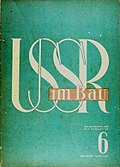Soviet Union (magazine)
| SOVIET UNION | |
|---|---|
| description | Culture, politics and business magazine |
| language | 19, Various |
| publishing company | Association of State Publishers of the RSFSR; State Art Publishing House, Moscow |
| First edition | 1930 |
| attitude | 1991 |
| Frequency of publication | per month |
| Sold edition | 1970s: 1.3 million copies |
| Editor-in-chief | I.a. Lissitzky , Rodchenko , Stepanowa , Alpert , Babel , Kolzow , Heartfield , Schaichet , Markow-Grinberg , Gribatschow |
| editor | Moscow collective of authors |
Soviet Union ( Russian Советский Союз / Sowetski Sojus ; spelling: SOWJET UNION), formerly U (d) SSR under construction (Russian СССР на стройке / SSSR na stroike ), was a multilingual, globally appearing magazine from the Soviet Union .
description
The socio-political magazine founded in 1930 by Maxim Gorky in Nizhny Novgorod reports documentary on the life of the population in the USSR. Mainly economic achievements, science, technology, culture and art are taken into account. Foreign policy is particularly dedicated. In addition to a fairy tale for children, the font also contains pages that are especially interesting for women. Questions and comments on specific articles will be answered in the next issue.
The strikingly large format, which measured around 412 × 300 mm, enabled wide, sometimes double-sided images and detailed text. Photographs were obtained from the Moscow agency Soyuzfoto . The relatively expensive editions were targeted at Western business people, intellectuals and leading members of communist parties. Josef Stalin was a constant reader of the book .
When the German-Soviet War began , the magazine was temporarily suspended. It was not until 1949 that another twelve editions were published. From 1950 the magazine appeared again under the name Soviet Union . In the 1970s, at the height of its existence, it was officially published in 130 countries, while the total circulation was 1.3 million copies. It has been translated into 19 languages, namely Russian, English, German, French (all from 1930), Spanish (from 1937), Chinese (1950), Korean (1954), Japanese (1955), Arabic, Serbo-Croatian, Urdu, Hindi (all from 1956), Finnish (1957), Romanian (1957), Hungarian (1958), Mongolian (1960), Bengali (1967), Vietnamese (1968) and Italian (1969). On January 7, 1980, the magazine was awarded the Order of Lenin . In 1991 the publication of the magazine was stopped.
Today the font is particularly popular among collectors. At a used goods auction in Russia in 2006, a collection of 47 issues fetched 200,000 rubles. The magazine Forbes estimates the value of an output, which is in good condition, to 200 to 500 US dollars. The value increases annually by 25 to 30 percent. However, some issues have a significantly higher value, such as B. those that were created under the editor-in-chief of Alexander Michailowitsch Rodtschenko or El Lissitzky .
Sports in the USSR
“Sport in the USSR” ( Russian Спорт в СССР / Sport w SSSR ) was the supplementary, likewise illustrated supplement to the magazine. Your pages were not just included in the delivery or at the magazine's sales stand, as is usually the case, but included in the magazine. It represented its own, almost separate section , while the remaining contents of the magazine, not following any particular sorting, rather formed a collage and were thematically unspecific strung together.
The supplement reported on the largest national and international sporting events and highlighted the importance of physical culture and sport in the Soviet Union. Numerous sports were also presented alongside their most prominent and successful representatives.
The total circulation in 1975 was 140,000 copies.
swell
- Article Sovetsky Soyuz in the Great Soviet Encyclopedia (BSE) , 3rd edition 1969–1978 (Russian)
- Article SSSR na stroike on trendsetter.ru (Russian)
